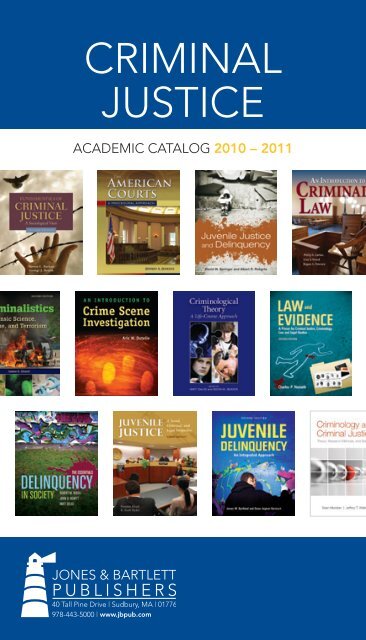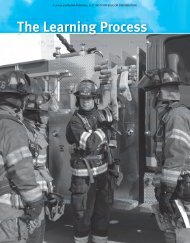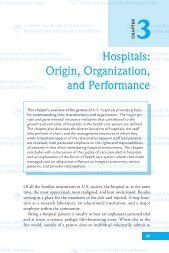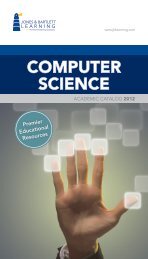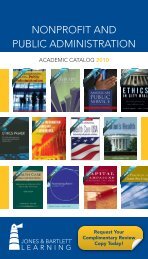Criminal Justice 2010.pdf - Jones & Bartlett Learning
Criminal Justice 2010.pdf - Jones & Bartlett Learning
Criminal Justice 2010.pdf - Jones & Bartlett Learning
Create successful ePaper yourself
Turn your PDF publications into a flip-book with our unique Google optimized e-Paper software.
CRIMINAL<br />
JUSTICE<br />
ACADEMIC CATALOG 2010 – 2011
LETTER FROM THE EDITOR<br />
OUR STORY<br />
Dear Colleague,<br />
We are proud to present our growing list of new<br />
and trusted resources for the study, instruction,<br />
and practice of <strong>Criminal</strong> <strong>Justice</strong>. As you look<br />
through our offerings, we invite you to contact<br />
us to request review copies, purchase books,<br />
and share your feedback. Your input is extremely<br />
important to us when developing and publishing<br />
new resources.<br />
As the editor for <strong>Jones</strong> & <strong>Bartlett</strong>’s <strong>Criminal</strong><br />
<strong>Justice</strong> titles, I would like to hear from you. If<br />
you have an idea for a book or would like to be<br />
considered as a reviewer, please contact us!<br />
<strong>Jones</strong> & <strong>Bartlett</strong> Publishers is a world-leading<br />
provider of instructional, assessment, and<br />
learning-performance management solutions<br />
for secondary, post-secondary, and professional<br />
markets. We endeavor to develop educational<br />
programs and services that improve learning<br />
outcomes, and enhance student achievement by<br />
uniquely combining authoritative content written<br />
by respected authors with innovative, proven,<br />
and engaging technology applications that<br />
meet the diverse needs of today’s instructors,<br />
students, and professionals.<br />
Our learning solutions are used in the following<br />
content areas:<br />
Sean Connelly<br />
Acquisitions Editor<br />
sconnelly@jbpub.com<br />
EMS, Fire & Safety – From emergency medical<br />
services and fire training, to first aid and CPR,<br />
construction safety, and law enforcement, <strong>Jones</strong><br />
& <strong>Bartlett</strong> is the leading provider of education<br />
and assessment resources for public safety<br />
professionals.<br />
Health & Medicine – Working directly with<br />
many of the world’s leading health science<br />
authors, thought-leaders, and professional<br />
associations, <strong>Jones</strong> & <strong>Bartlett</strong> produces marketleading<br />
college textbooks, electronic reference<br />
materials, drug reference handbooks, and<br />
patient education materials for consumers of<br />
healthcare services.<br />
Science, Computing, Engineering &<br />
Mathematics – From human biology to complex<br />
analysis, <strong>Jones</strong> & <strong>Bartlett</strong> is transforming<br />
scientific and technical learning with tools<br />
designed to enrich the learning experience and<br />
improve course outcomes.<br />
Sign Up to Receive Updates and<br />
Special Offers by E-mail<br />
www.jbpub.com/eUpdates<br />
Career Education & Trades – With marketleading<br />
brands such as CDX Automotive—an<br />
innovative training solution for automotive<br />
service technicians—<strong>Jones</strong> & <strong>Bartlett</strong> is<br />
redefining how skill-based education is delivered<br />
for the career education market.<br />
For more information or to review our online<br />
product catalog, visit us on the web at<br />
www.jbpub.com.<br />
40 Tall Pine Drive | Sudbury, MA | 01776 | 978-443-5000 | www.jbpub.com
CONTENTS<br />
Introductory <strong>Criminal</strong> <strong>Justice</strong> 5-6<br />
Juvenile Delinquency and <strong>Justice</strong> 7-8<br />
<strong>Criminal</strong> Law 9<br />
Introduction to Corrections 10<br />
<strong>Criminal</strong> Investigation and Forensic Science 11-15<br />
Criminology 16-17<br />
Courts, Law, and Procedure 18-19<br />
<strong>Criminal</strong> <strong>Justice</strong> Policy 20<br />
Statistics and Research Methods 21<br />
Special Topics 22-23<br />
Policing 24<br />
Community and Institutional Corrections 25<br />
Corrections Management 26<br />
Security 27<br />
4 Easy Ways to Order<br />
1. Toll Free: 1-800-832-0034<br />
2. Fax: 978-443-8000<br />
3. Mail: 40 Tall Pine Drive,<br />
Sudbury, MA 01776<br />
4. Web: www.jbpub.com<br />
Textbook Examination Copies<br />
Complimentary † review copies are<br />
available for qualified instructors who<br />
wish to consider a text for course<br />
adoption. For fastest service, make<br />
your request online at www.jbpub.com<br />
or let our knowledgeable publisher’s<br />
representatives help you find the text<br />
that best meets your course needs.<br />
Addtional Formats<br />
A number of our titles are available as<br />
eTextbooks on CourseSmart and can be<br />
purchased at www.CourseSmart.com.<br />
Wherever these formats are available,<br />
they are noted.<br />
A Note about Student and<br />
Instructor Resources<br />
Many of our textbooks are<br />
accompanied by print and online<br />
instructor and student resources.<br />
Wherever these resources are<br />
available, they are noted as follows:<br />
Instructor Resources:<br />
CO = Chapter Outlines<br />
CW = Companion Web site<br />
IM = Instructor’s Manual<br />
ITK = Instructor’s ToolKit<br />
LO = Lecture Outlines<br />
PP = PowerPoint Slides<br />
SL = Sample Syllabus<br />
TB = TestBank<br />
Student Resources:<br />
CW = Companion Web site<br />
CQ = Interactive Chapter Quizzes<br />
DS = Sample Data Sets<br />
FL = Interactive Flashcards<br />
IG = Interactive Glossary<br />
SG = Study Guide<br />
WL = Web Links<br />
†<strong>Jones</strong> and <strong>Bartlett</strong> Publishers reserves the right to evaluate requests for complimentary review copies. *Suggested U.S. list price. Prices are<br />
subject to change. Shipping and sales tax will be applied to your order. If you are not completely satisfied with your purchase, please return it<br />
within 30 days for a full refund or replacement copy.
NEW FOR 2010<br />
New for 2010<br />
Fundamentals of <strong>Criminal</strong> <strong>Justice</strong>: A Sociological View,<br />
Second Edition . . . . . . . . . . . . . . . . . . . . . . . . . . . . . . . . . . . 6<br />
Juvenile Delinquency:<br />
An Integrated Approach, Second Edition . . . . . . . . . . . . . . 7<br />
Delinquency in Society: The Essentials . . . . . . . . . . . . . . . . . . 7<br />
Juvenile <strong>Justice</strong> and Delinquency . . . . . . . . . . . . . . . . . . . . . . 8<br />
An Introduction to <strong>Criminal</strong> Law. . . . . . . . . . . . . . . . . . . . . . . . 9<br />
An Introduction to Crime Scene Investigation . . . . . . . . . . . 11<br />
<strong>Criminal</strong>istics: Forensic Science, Crime,<br />
and Terrorism, Second Edition . . . . . . . . . . . . . . . . . . . . . . 12<br />
Law and Evidence: A Primer for <strong>Criminal</strong> <strong>Justice</strong>,<br />
Criminology, Law, and Legal Studies,<br />
Second Edition . . . . . . . . . . . . . . . . . . . . . . . . . . . . . . . . . . 13<br />
Serial Offenders: Theory and Practice . . . . . . . . . . . . . . . . . . 13<br />
Interviewing in <strong>Criminal</strong> <strong>Justice</strong> . . . . . . . . . . . . . . . . . . . . . . . 15<br />
Criminological Theory: A Life-Course Approach . . . . . . . . . 16<br />
The American Courts: A Procedural Approach . . . . . . . . . . . 18<br />
Understanding the Constitution . . . . . . . . . . . . . . . . . . . . . . . 19<br />
Drugs and Alcohol in the 21st Century:<br />
Theory, Behavior, and Policy . . . . . . . . . . . . . . . . . . . . . . . . 20<br />
U.S. <strong>Criminal</strong> <strong>Justice</strong> Policy: A Contemporary Reader . . . . . 20<br />
Criminology and <strong>Criminal</strong> <strong>Justice</strong>:<br />
Theory, Research Methods, and Statistics . . . . . . . . . . . . . 21<br />
Race, Ethnicity, and the <strong>Criminal</strong> <strong>Justice</strong> System . . . . . . . . . 22<br />
Computer Forensics: Computer Crime<br />
Scene Investigation, Third Edition . . . . . . . . . . . . . . . . . . . 27<br />
4<br />
40 Tall Pine Drive | Sudbury, MA | 01776 | 978-443-5000 | www.jbpub.com
INTRODUCTORY CRIMINAL JUSTICE<br />
Exploring <strong>Criminal</strong> <strong>Justice</strong><br />
The Essentials<br />
Robert M. Regoli, PhD, University of Colorado at Boulder<br />
John D. Hewitt, PhD, Grand Valley State University<br />
Praise for this text:<br />
I find this text to be very<br />
comprehensive. The factual and<br />
historical data provide an extensive<br />
resource for faculty. Not only are<br />
fundamental issues covered, but<br />
the chapter summaries include<br />
thought-provoking questions that<br />
allow for application of critical<br />
thinking skills.<br />
— Linda L. Fleischer,<br />
The Community College of<br />
Baltimore County<br />
Exploring <strong>Criminal</strong> <strong>Justice</strong>: The Essentials<br />
engages students in an exploration of the<br />
American criminal justice system by examining<br />
the people and processes that make up the<br />
system, and how they interact and work together.<br />
This comprehensive text includes coverage of law<br />
enforcement, corrections, juvenile justice systems,<br />
law and policy making, administration, and the<br />
courts.<br />
Key Features<br />
• Careers in <strong>Criminal</strong> <strong>Justice</strong> helps students<br />
understand what opportunities are available<br />
to them in the criminal justice systems.<br />
• Focus on <strong>Criminal</strong> <strong>Justice</strong> explores the<br />
nature of crime and the criminal justice<br />
response concerning different issues.<br />
• Headline Crime highlights recent highprofile<br />
cases and current events.<br />
• Around the Globe discusses law and law<br />
enforcement around the world.<br />
Companion Web Site Resources<br />
For Instructors<br />
- Chapter Outlines<br />
- PowerPoint Presentations<br />
- TestBank<br />
Online Student Study Guide offers:<br />
- Career Resources<br />
- Chapter Objectives and Spotlights<br />
- Crossword Puzzle<br />
- Flashcards<br />
- Glossary<br />
- Practice Tests<br />
- And More...<br />
Bundle Options<br />
Exploring <strong>Criminal</strong> <strong>Justice</strong>: The Essentials with<br />
access to the Online Student Study Guide.<br />
ISBN-13: 978-0-7637-7823-1<br />
ISBN-13: 978-0-7637-5648-2 • Paperback • 427 Pages • © 2010 • Additional Formats: CourseSmart<br />
Sign Up to Receive Updates and Special Offers: www.jbpub.com/eupdates 5
INTRODUCTORY CRIMINAL JUSTICE<br />
Fundamentals of <strong>Criminal</strong><br />
<strong>Justice</strong><br />
A Sociological View,<br />
Second Edition<br />
Steven E. Barkan, PhD<br />
George J. Bryjak, PhD<br />
The criminal justice system is a key social<br />
institution in the lives of citizens everywhere.<br />
Fundamentals of <strong>Criminal</strong> <strong>Justice</strong>: A<br />
Sociological View, Second Edition provides a<br />
unique social context to explore and explain the<br />
nature, impact, and significance of the criminal<br />
justice system in everyday life. This introductory<br />
text examines important sociological issues<br />
including class, race, and gender inequality. The<br />
effectiveness of criminal justice in controlling<br />
and reducing crime is critically examined to<br />
bring readers to a deeper understanding of the<br />
operation of the criminal justice system and the<br />
genesis of crime and victimization.<br />
Key Features<br />
• Explores international issues, such as<br />
Islamic justice and European sentencing<br />
practices, for a comprehensive analysis of<br />
critical social topics.<br />
• Features controversial current events, such<br />
as police corruption and prison crowding,<br />
to engage readers with interesting and<br />
timely information.<br />
• Poses hypothetical situations and review<br />
questions to initiate provocative classroom<br />
discussions.<br />
ISBN-13: 978-0-7637-5424-2 • Paperback<br />
500 Pages • © 2011 • Available Fall 2010<br />
Exploring <strong>Criminal</strong> <strong>Justice</strong><br />
Robert M. Regoli, PhD,<br />
University of Colorado at Boulder<br />
John D. Hewitt, PhD,<br />
Grand Valley State University<br />
Exploring <strong>Criminal</strong> <strong>Justice</strong> provides a clear,<br />
complete, and credible introduction to the U.S.<br />
criminal justice system. Using an easy-to-follow<br />
writing style, this text explains the overarching<br />
processes and purposes of the criminal justice<br />
system. In addition, this text provides thorough<br />
integration of criminological theory and policy,<br />
as it presents both historical context and current<br />
features of the U.S. criminal justice system.<br />
Key Features<br />
• Focus on <strong>Criminal</strong> <strong>Justice</strong> explores the<br />
nature of crime and the criminal justice<br />
response to incidents.<br />
• Thinking About Crime and <strong>Justice</strong><br />
challenges readers to think like practicing<br />
criminal justice professionals with realworld<br />
case studies and accompanying<br />
discussion questions.<br />
• Around the Globe offers a window into law<br />
and law enforcement around the world.<br />
• Voice of the Court provides summaries and<br />
excerpts from court rulings which have helped<br />
shape the criminal justice system and process.<br />
ISBN-13: 978-0-7637-4284-3 • Hardcover<br />
549 Pages • © 2008<br />
Instructor Resources: ITK, CW: LO, PP, TB<br />
Student Resources: CW: CO, CQ, FL, IG<br />
6<br />
40 Tall Pine Drive | Sudbury, MA | 01776 | 978-443-5000 | www.jbpub.com
JUVENILE DELINQUENCY AND JUSTICE<br />
Juvenile Delinquency<br />
An Integrated Approach,<br />
Second Edition<br />
James Burfeind, PhD,<br />
University of Montana<br />
Dawn Jeglum Bartusch, PhD,<br />
Valparaiso University<br />
Juvenile Delinquency: An Integrated Approach,<br />
Second Edition offers a comprehensive<br />
introduction to juvenile delinquency. Now<br />
in a more concise and accessible format, this<br />
text cultivates an understanding of juvenile<br />
delinquency by examining and linking key<br />
sociological and criminological theories<br />
and research. Biological and psychological<br />
approaches to delinquency are covered, as<br />
well as responses to delinquent behavior<br />
including prevention, early intervention, and<br />
contemporary juvenile justice.<br />
Key Features<br />
• New research and updated delinquency<br />
and juvenile justice data provide the most<br />
current information and statistics.<br />
• New chapters on delinquency prevention<br />
and intervention and the “delinquent event”<br />
offer a larger breadth of topics covered.<br />
• New changes in juvenile justice thought and<br />
practice, including the growing popularity<br />
of more punitive approaches to delinquency<br />
and a reawakening of the “rehabilitative<br />
ideal.”<br />
ISBN-13: 978-0-7637-5810-3 • Paperback<br />
416 Pages • © 2011<br />
Instructor Resources: PP, TB<br />
Delinquency in Society<br />
The Essentials<br />
Robert M. Regoli, PhD,<br />
University of Colorado at Boulder<br />
John D. Hewitt, PhD,<br />
Grand Valley State University<br />
Matt DeLisi, PhD, Iowa State University<br />
Delinquency in Society: The Essentials is a<br />
concise introduction to the important topics<br />
covered by the same authors in the popular<br />
Delinquency in Society, Eighth Edition. This<br />
practical text explores how juvenile delinquency is<br />
defined, measured, and explained, as well as how<br />
the juvenile justice system deals with delinquent<br />
youth. The new Essentials text provides separate<br />
chapters focusing on the police, juvenile courts,<br />
corrections, and delinquency prevention.<br />
Key Features<br />
• Detailed descriptions of delinquency,<br />
criminal acts, and status offenses performed<br />
by the juvenile population.<br />
• Coverage of principle theories including<br />
Cultural Deviance, Strain, and Life Course.<br />
• Cutting-edge discussion of the biosocial<br />
paradigm that articulates the interplay<br />
between nature and nurture in the<br />
development of delinquency.<br />
ISBN-13: 978-0-7637-7790-6 • Paperback<br />
400 Pages • © 2011 • Available Spring 2010<br />
Instructor Resources: CW: LO, PP, TB<br />
Student Resources: CW: CO, CQ,WL<br />
Sign Up to Receive Updates and Special Offers: www.jbpub.com/eupdates 7
JUVENILE DELINQUENCY AND JUSTICE<br />
Delinquency in Society<br />
Eighth Edition<br />
Robert M. Regoli, PhD<br />
John D. Hewitt, PhD<br />
Matt DeLisi, PhD<br />
Delinquency in Society, Eighth Edition provides a systematic<br />
introduction to the study of juvenile delinquency, criminal behavior,<br />
and status offending youths. This text examines the theories of juvenile<br />
crimes and the social context of delinquency including the relevance<br />
of families, schools, and peer groups. Reorganized and thoroughly<br />
updated to reflect the most current trends and developments in juvenile<br />
delinquency, the Eighth Edition includes discussions of the history,<br />
institutional context, and societal reactions to delinquent behavior.<br />
ISBN-13: 978-0-7637-6434-0<br />
Hardcover • 674 Pages • © 2010 • Additional Formats: CourseSmart<br />
Instructor Resources: CW: LO, PP, TB<br />
Student Resources: CW: CO, CP, CQ, FL, IG, WL<br />
Juvenile <strong>Justice</strong> and Delinquency<br />
David W. Springer, PhD<br />
Albert R. Roberts, PhD, BCETS, DACFE, Rutgers University<br />
This is the first text to comprehensively trace the progress toward<br />
resolving critical juvenile justice and delinquency issues, and to provide<br />
cutting-edge intervention strategies to effectively rehabilitate juvenile<br />
offenders and prevent delinquency. Historical, political, and legal trends<br />
are examined and critiqued, as well as the range of developmental,<br />
familial, and sociological theoretical explanations of juvenile<br />
delinquency. Current evidence-based practice, prevention strategies<br />
and programs, and juvenile justice treatment and policy alternatives are<br />
thoroughly explored.<br />
ISBN-13: 978-0-7637-6056-4 • Paperback • 528 Pages • © 2011<br />
Instructor Resources: PP, TB<br />
Juvenile <strong>Justice</strong><br />
A Social, Historical, and Legal Perspective, Third<br />
Edition<br />
Preston Elrod, PhD, Department of Safety, Security, and<br />
Emergency Management, Eastern Kentucky University<br />
R. Scott Ryder, JD, Tribal Court Administrator, ICWA Attorney,<br />
Instructor, Glenn Oaks Community College<br />
The juvenile justice system is a multifaceted entity that continually changes<br />
under the influence of decisions, policies, and laws. The all new Third<br />
Edition of Juvenile <strong>Justice</strong>: A Social, Historical, and Legal Perspective,<br />
offers readers a clear and comprehensive look at exactly what it is and<br />
how it works. Reader friendly and up-to-date, this text unravels the<br />
complexities of the juvenile justice system by exploring the history, theory,<br />
and components of the juvenile justice process and how they relate.<br />
ISBN-13: 978-0-7637-6251-3 • Hardcover • 523 Pages • © 2011<br />
Instructor Resources: IM, LO, PP, TB<br />
8<br />
40 Tall Pine Drive | Sudbury, MA | 01776 | 978-443-5000 | www.jbpub.com
CRIMINAL LAW<br />
An Introduction to<br />
<strong>Criminal</strong> Law<br />
Philip E. Carlan, PhD,<br />
University of Southern Mississippi<br />
Lisa S. Nored, JD,<br />
University of Southern Mississippi<br />
Ragan A. Downey,<br />
University of Southern Mississippi<br />
This text walks readers through a chronological<br />
and simplistic, yet detailed, dissection of the<br />
legal labyrinth. The principles of criminal<br />
law are explained step-by-step with a focus<br />
on the professional applications of legal<br />
principles within the criminal justice system.<br />
Recent evolving legislation pertaining to<br />
terrorism, organized crime, and white-collar<br />
crime are addressed. Written in an engaging<br />
conversational tone, this resource is ideal for<br />
undergraduate criminal law courses.<br />
Key Features<br />
• Provides supportive examples and<br />
hypothetical illustrations to deepen<br />
understanding of important topics.<br />
• Authored by an attorney and non-attorney<br />
to offer a balanced and accessible viewpoint.<br />
• Full of practical hands-on exercises and<br />
chapter-by-chapter questions and answers<br />
to enhance student learning.<br />
ISBN-13: 978-0-7637-5525-6<br />
Hardcover • 224 Pages • © 2011<br />
Instructor Resources: PP, TB<br />
<strong>Criminal</strong> Law<br />
Second Edition<br />
David C. Brody, JD, PhD, Washington<br />
State University - Spokane<br />
James R. Acker, JD, PhD, University at<br />
Albany<br />
This highly anticipated Second Edition introduces<br />
readers to the principles, legal doctrine, and<br />
rules of criminal law. Innovative in its case study<br />
approach, this thoroughly updated revision<br />
will help readers develop analytical skills, while<br />
learning the content and context of substantive<br />
criminal law. Now with a more student-friendly<br />
format, this text guides learners through theory<br />
and practice, using a blend of old and new<br />
materials to foster an understanding of what<br />
the law is, how it evolved, and how it applies to<br />
various circumstances.<br />
Key Features<br />
• Important developments and new materials on<br />
the “war on terrorism,” anti-stalking legislation,<br />
the prosecution of cybercrimes, and more.<br />
• Updated information on assisted suicide<br />
prohibitions, anti-sodomy laws, and the<br />
constitutionality of implementing the death<br />
penalty for crimes not involving homicide.<br />
• Chapter objectives and review questions in<br />
every chapter to assist readers in developing<br />
critical thinking skills and comprehension<br />
of material.<br />
ISBN-13: 978-0-7637-5913-1<br />
Hardcover • 412 Pages • © 2010<br />
Instructor Resources: IM, TB<br />
Sign Up to Receive Updates and Special Offers: www.jbpub.com/eupdates 9
INTRODUCTION TO CORRECTIONS<br />
American Corrections<br />
Theory, Research, Policy, and Practice<br />
Matt DeLisi, PhD, Iowa State University<br />
Peter J. Conis, PhD, Iowa State University<br />
This comprehensive resource provides both classic and cutting-edge data on<br />
correctional topics drawing from the fields of criminology, criminal justice,<br />
sociology, psychology, government, and public policy. The hallmark of<br />
American Corrections: Theory, Research, Policy, and Practice is its thesis—<br />
that the American criminal justice system, particularly the corrections<br />
domain, is in theory and practice a system for the management of risk. By<br />
demonstrating that correctional systems balance public safety with providing<br />
treatment and supervision to offenders, this text tells the story of corrections<br />
within a coherent, criminological framework.<br />
ISBN-13: 978-0-7637-5487-7 • Hardcover<br />
586 Pages • © 2010 • Additional Format: CourseSmart<br />
Instructor Resources: CW: CO, PP, TB<br />
Student Resources: CW: CP, CQ, FL, IG, WL<br />
Corrections and the <strong>Criminal</strong> <strong>Justice</strong> System<br />
David C. May, PhD<br />
Kevin I. Minor, PhD<br />
Rick Ruddell, PhD<br />
Betsy A. Matthews, PhD<br />
All of Eastern Kentucky University<br />
Corrections and the <strong>Criminal</strong> <strong>Justice</strong> System is designed to help students<br />
understand corrections in relation to the entire criminal justice system.<br />
This text begins with an overview of the field of criminal justice and<br />
covers the components of the criminal justice system that an offender<br />
must pass through prior to his or her corrections experience (police,<br />
courts, and sentencing). The second part of the text shows students how<br />
corrections is interconnected and related to the other aspects of the<br />
criminal justice system.<br />
ISBN-13: 978-0-7637-3500-5 • Paperback • 585 Pages • © 2008<br />
Instructor Resources: LO, PP, TB<br />
Prisons<br />
Today and Tomorrow, Second Edition<br />
Joycelyn M. Pollock, PhD, JD,<br />
Texas State University-San Marcos<br />
Prisons Today and Tomorrow, Second Edition uses current case studies<br />
and research to present balanced and comprehensive coverage of prisons<br />
and prisoners. Featuring chapters contributed by leading authorities<br />
on the modern prison system, this text examines the many purposes of<br />
prisons—punishment, deterrence, rehabilitation, and incapacitation—<br />
and examines controversial issues such as whether imprisonment<br />
actually deters crime or merely serves as punishment.<br />
ISBN-13: 978-0-7637-2904-2 • Hardcover • 316 Pages • © 2006<br />
Instructor Resources: IM, PP<br />
10<br />
40 Tall Pine Drive | Sudbury, MA | 01776 | 978-443-5000 | www.jbpub.com
CRIMINAL INVESTIGATION AND FORENSIC SCIENCE<br />
Praise for this text:<br />
This is the CSI text that I, and<br />
many of my colleges have been<br />
waiting for… written about<br />
processing a crime scene, by a<br />
former officer who actually worked<br />
in real crime scenes.<br />
— Joseph LeFevre, University of<br />
Wisconsin - Platteville<br />
An Introduction to Crime Scene Investigation<br />
Aric W. Dutelle, MFS, <strong>Criminal</strong> <strong>Justice</strong> Department, University of Wisconsin-Platteville<br />
In a world profoundly influenced by<br />
popular media programs, the real-life duties<br />
and complexities involved in crime scene<br />
investigation are often misrepresented and<br />
misunderstood. An Introduction to Crime<br />
Scene Investigation serves to eliminate warped<br />
impressions and to clearly identify and accurately<br />
explain the crime scene investigative process,<br />
components, methods, and procedures. This<br />
comprehensive introductory text exposes<br />
readers to the day-to-day aspects of crime scene<br />
processing, and describes in detail the crime<br />
scene investigator responsibilities. The history<br />
related to crime scene investigation, theory,<br />
ethics, social impact, training, and educational<br />
issues are thoroughly explored as well.<br />
Key Features<br />
• Presents straightforward and scientifically<br />
supported procedures that explain how to<br />
accurately and efficiently document what has<br />
been left behind at the scene of a crime.<br />
• Provides an in-depth look at the CSI world<br />
through over 100 photographs, illustrations,<br />
and short narrative segments that will guide<br />
the reader through investigations.<br />
• Effectively covers a variety of investigations<br />
such as burglary, homicide, sex crimes, drug<br />
cases, underwater crime scenes, hazardous<br />
materials situations, and arson.<br />
• Offers a pragmatic, critical, and<br />
multidisciplinary approach for readers<br />
with little or no background in crime scene<br />
investigation.<br />
• “Ripped From the Headlines” Current<br />
Event Examples: “Real world” incidents<br />
involving the content are discussed in every<br />
chapter. This application to “real world”<br />
situations will enable the reader to better<br />
grasp the concepts and theories presented.<br />
• “Case in Point” Examples: In addition to<br />
current events, there are also case scenarios<br />
and summations which assist the reader<br />
in further comprehending the presented<br />
material.<br />
• “View from an Expert” Insights: Many<br />
chapters include these insights from a<br />
forensic expert within the chapter content<br />
field.<br />
• Case Studies: End-of-chapter case studies<br />
will challenge readers to seek additional<br />
information from outside sources to assist<br />
them with a more in-depth comprehension<br />
of the presented material.<br />
ISBN-13: 978-0-7637-6241-4 • Paperback • 538 Pages • © 2011<br />
Instructor Resources: PP, TB Student Resources: CW<br />
Sign Up to Receive Updates and Special Offers: www.jbpub.com/eupdates 11
CRIMINAL INVESTIGATION AND FORENSIC SCIENCE<br />
<strong>Criminal</strong> Investigation<br />
Third Edition<br />
Ronald Becker, JD, Chaminade University<br />
This introductory text takes an integrated<br />
approach to the investigative process. It explores<br />
how contributors to criminal investigation—<br />
and its resulting prosecution—are more<br />
effective when they understand and appreciate<br />
their role on the team, what role other team<br />
members play, and how it all comes together.<br />
Readers will learn how investigations are<br />
connected to a team that is much larger than<br />
those charged with the investigations of a crime.<br />
The end result is a solid foundation in criminal<br />
investigation.<br />
Key Features<br />
• New information on underwater<br />
investigations and CSI related topics<br />
including computer and internet based<br />
investigations and fingerprinting.<br />
• Coverage of the reorganization and<br />
updating of information related to Private<br />
Security investigations, such as background<br />
checks, surveillance, and retail-loss<br />
prevention.<br />
• Increased sections on terrorism discuss<br />
new topics such as asymmetric warfare and<br />
infrastructure vulnerability.<br />
ISBN-13: 978-0-7637-5522-5 • Hardcover<br />
581 Pages • © 2009 • Additional Format: CourseSmart<br />
Instructor Resources: IM, PP, TB<br />
<strong>Criminal</strong>istics<br />
Forensic Science, Crime, and<br />
Terrorism, Second Edition<br />
James E. Girard, PhD, American University<br />
This updated Second Edition introduces readers<br />
with no background in biology or chemistry to<br />
the study of forensic science, crime analysis, and<br />
application. Principal topics such as fingerprint<br />
identification, DNA, paint and glass analysis,<br />
drug toxicology, and forensic soil characterization<br />
are thoroughly explained in a reader-friendly<br />
manner. Unlike other texts available on this<br />
topic, this Second Edition is updated to include<br />
comprehensive coverage on important homeland<br />
security issues including explosives, weapons of<br />
mass destruction, and cybercrime.<br />
Key Features<br />
• New case studies and updated sections on<br />
analysis of fingerprints and questioned<br />
documents offer recent developments and<br />
findings in this critical field.<br />
• New information on chemistry and biology<br />
equip readers with the foundation and tools<br />
necessary to understand more advanced<br />
topics.<br />
• Extensive updating of Chapter 11, “Drug<br />
Use and Abuse,” provides the latest methods<br />
of drug testing and analysis by federal and<br />
state law enforcement agencies.<br />
ISBN-13: 978-0-7637-7731-9 • Hardcover<br />
500 Pages • © 2011 • Available Fall 2010<br />
Instructor Resources: CW: LO, PP TB<br />
Student Resources: CW<br />
12<br />
40 Tall Pine Drive | Sudbury, MA | 01776 | 978-443-5000 | www.jbpub.com
CRIMINAL INVESTIGATION AND FORENSIC SCIENCE<br />
Law and Evidence<br />
A Primer for <strong>Criminal</strong> <strong>Justice</strong>,<br />
Criminology, Law, and Legal<br />
Studies, Second Edition<br />
Charles P. Nemeth, JD, PhD, California<br />
University of Pennsylvania<br />
Law and Evidence: A Primer for <strong>Criminal</strong><br />
<strong>Justice</strong>, Criminology, Law, and Legal Studies,<br />
Second Edition introduces the complex topics<br />
of evidence law in a straightforward and<br />
accessible manner. The use and function of<br />
criminal evidence and civil evidence in cases is<br />
examined to offer a complete understanding<br />
of how evidence principles play out in the real<br />
world of litigation and advocacy. This revised<br />
Second Edition offers a historical overview,<br />
perfect for non-law students from a variety of<br />
backgrounds.<br />
Key Features<br />
• Every chapter contains new legal authority<br />
which applies to traditional legal principles<br />
relevant to evidence law.<br />
• Offers full coverage of evidentiary codes<br />
and statutes.<br />
• Filled with practical forms, checklists, and<br />
additional tools for future practitioners.<br />
ISBN-13: 978-0-7637-6661-0 • Paperback<br />
325 Pages • © 2011 • Available Spring 2010<br />
Serial Offenders<br />
Theory and Practice<br />
Dr. Kevin Borgeson, Salem State College,<br />
Massachusetts<br />
Serial Offenders: Theory and Practice explores<br />
the act of criminal profiling and the effective<br />
methods of case analysis and linkage. Intriguing<br />
case studies are used to thoroughly examine<br />
the behavioral aspects of serial homicide and<br />
the investigative issues that criminal justice<br />
professionals face. Readers will learn how to<br />
build hypotheses, construct timelines, and<br />
develop suspect lists. Successful interview<br />
and interrogation skills and methods are also<br />
covered.<br />
Key Features<br />
• A model theory for understanding copycat<br />
serial killers is included to recognize how<br />
the media and high profile serial offender<br />
cases influence individuals.<br />
• An updated social psychological model<br />
of serial homicide is emphasized to bring<br />
readers to a better understanding of serial<br />
practice.<br />
• Cases analysis and profiling exercises<br />
are included to give readers hands on<br />
application of valuable techniques.<br />
ISBN-13: 97-8-07637-7730-2 • Paperback<br />
325 Pages • © 2011 • Available Summer 2010<br />
Sign Up to Receive Updates and Special Offers: www.jbpub.com/eupdates 13
CRIMINAL INVESTIGATION AND FORENSIC SCIENCE<br />
Hunting Serial Predators<br />
Second Edition<br />
G. Maurice Godwin, PhD,<br />
Godwin Trial & Forensic Consultancy, Inc.<br />
Written by a leading expert on the subject, the<br />
new Second Edition describes the empirical<br />
process used to analyze serial murderers’ crime<br />
scene actions, making it possible to form logical<br />
decisions about how to detect and apprehend<br />
serial killers. This text also gives an overview of<br />
the related scientific knowledge, introduces a<br />
new method to classify the serial predator, and<br />
provides accounts of the process and difficulties<br />
of profiling the serial murderer.<br />
Key Features<br />
• Clearly explains “Investigative Process<br />
Management”—a term which encompasses<br />
applications of psychology and improves<br />
investigative decision-making strategies.<br />
• Integration of statistical methods and<br />
behavioral theories helps students answer<br />
the question: “Why are some people more<br />
prone to committing crimes?”<br />
• Uses a model of the crime scene actions<br />
of American serial murderers based on<br />
information available to a police inquiry.<br />
ISBN-13: 978-0-7637-3510-4 • Paperback<br />
268 Pages • © 2008<br />
Instructor Resources: PP, TB<br />
Fundamentals of Crime<br />
Mapping<br />
Rebecca Paynich, PhD, Curry College<br />
Bryan Hill, Crime Analyst, Glendale Police<br />
Department, Arizona<br />
Fundamentals of Crime Mapping walks readers<br />
through the research, theories, and history of<br />
Graphic Information Systems (GIS) in law<br />
enforcement. The day-to-day practical application<br />
of crime analysis for mapping is explained. Factual<br />
data from real crime analysis is included to reflect<br />
actual crime patterns, trends, series, and what an<br />
officer or analyst can expect to see when he or she<br />
sits down to analyze and apply concepts learned.<br />
Special topics discussed include: an up-to-date<br />
discussion of the current crime trends in rural<br />
and urban areas, the major ecological theories of<br />
crime, empirical research using crime mapping<br />
tools, and more.<br />
Key Features<br />
• Provides jargon-free language, over 30<br />
practical exercises, and a large assortment<br />
of varied data that can be used for<br />
additional exercises to maximize reader<br />
comprehension.<br />
• Packaged with a DVD that contains every<br />
chapter exercise along with full-color<br />
screenshots and images.<br />
• Contains a tutorial on the basics of using<br />
MS Excel 2003 for specific crime analysis<br />
applications as an addendum for those who<br />
are unfamiliar with MS Excel.<br />
ISBN-13: 978-0-7637-5575-1 • Paperback<br />
552 Pages • © 2010<br />
Instructor Resources: PP, SL, TB<br />
14<br />
40 Tall Pine Drive | Sudbury, MA | 01776 | 978-443-5000 | www.jbpub.com
CRIMINAL INVESTIGATION AND FORENSIC SCIENCE<br />
Interviewing in <strong>Criminal</strong> <strong>Justice</strong><br />
Vivian Lord, PhD, University of North Carolina-Charlotte<br />
Allen D. Cowan<br />
Obtaining valid and complete information is one of the most critical<br />
skills that any professional working in the criminal justice field can<br />
possess. Interviewing in <strong>Criminal</strong> <strong>Justice</strong> teaches the fundamentals<br />
of effective interviewing, including critical communication skills,<br />
interpretation skills, and how to effectively relay information. This solid<br />
resource prepares criminal justice students and professionals in other<br />
fields how to assess probation clients, communicate with juveniles,<br />
collect information from defendants, and much more.<br />
ISBN-13: 978-0-7637-6643-6<br />
Paperback • 328 Pages • © 2011 • Available Spring 2010<br />
Essentials of the Reid Technique<br />
<strong>Criminal</strong> Interrogation and Confessions<br />
Fred E. Inbau<br />
John E. Reid<br />
Joseph P. Buckley<br />
Brian C. Jayne<br />
This concise text teaches readers how to spot and interpret verbal<br />
and nonverbal behaviors of both deceptive and truthful people, and<br />
how to move toward obtaining solid confessions from guilty persons.<br />
Separated into two parts, What You Need to Know About Interrogation<br />
and Employing the Reid Nine Steps of Interrogation, this book will help<br />
readers understand the effective and proper way that a suspect should<br />
be interrogated and the safeguards that should be in place to ensure the<br />
integrity of the confession.<br />
ISBN-13: 978-0-7637-2728-4 • Paperback • 253 Pages • © 2005<br />
<strong>Criminal</strong> Interrogation and Confessions<br />
Fourth Edition<br />
Fred E. Inbau<br />
John E. Reid<br />
Joseph P. Buckley<br />
Brian C. Jayne<br />
<strong>Criminal</strong> Interrogation and Confessions, Fourth Edition explores the<br />
Reid Technique of interviewing and interrogation and is the standard<br />
used in the field. This practical text is built around simple psychological<br />
principles and examines interrogation as a nine-step process that is easily<br />
understood by students. The Fourth Edition presents interviewing and<br />
interrogation techniques, based on actual criminal cases, which have<br />
been used successfully by thousands of criminal investigators.<br />
ISBN-13: 978-0-7637-4721-3 • Hardcover • 639 Pages • © 2004<br />
Sign Up to Receive Updates and Special Offers: www.jbpub.com/eupdates 15
CRIMINOLOGY<br />
Criminology<br />
Theory, Research, and Policy,<br />
Second Edition<br />
Gennaro F. Vito, PhD,<br />
University of Louisville<br />
Jeffrey R. Maahs, PhD,<br />
University of Minnesota-Duluth<br />
Ronald M. Holmes, EdD,<br />
University of Louisville<br />
This Second Edition provides comprehensive<br />
coverage of the leading criminological theories<br />
using sociology, psychology, biology, and ecology<br />
to explain how and why crime occurs. The text<br />
combines classical criminology with timely<br />
topics including substance abuse, gang violence,<br />
Internet crimes, and terrorism. Using a social<br />
sciences approach, the authors discuss how<br />
criminology influences public policy throughout<br />
the text.<br />
Key Features<br />
• “Theory in Action” – Boxed notes<br />
throughout the text relate theoretical<br />
premises to real-world cases and events.<br />
• “You Are the Criminologist” – Realistic<br />
case studies and accompanying discussion<br />
questions challenge readers to think like a<br />
practicing criminologist.<br />
• “Headline Crime” – Recent high-profile<br />
crimes are highlighted and pose discussion<br />
questions relating to relevant theories.<br />
ISBN-13: 978-0-7637-3001-7 • Hardcover<br />
496 Pages • © 2007<br />
Instructor Resources: ITK, CW: LO, PP, TB<br />
Student Resources: CW, SG<br />
Criminological Theory<br />
A Life-Course Approach<br />
Matt DeLisi, PhD, Iowa State University<br />
Kevin M. Beaver, Florida State University -<br />
Tallahassee<br />
Criminological Theory: A Life-Course<br />
Approach explores criminal and antisocial<br />
behavior by examining important factors<br />
occurring at each stage of life. This collection<br />
of cutting-edge scholarship comprehensively<br />
covers life-course antisocial behavior ranging<br />
from prenatal factors, to childhood examples<br />
of disruptive behavior, delinquency, and adult<br />
crime. Diverse research from internationally<br />
recognized experts on criminal behavior brings<br />
readers toward a sharpened understanding of<br />
crime and the prevailing life-course approach.<br />
Key Features<br />
• Provides an interdisciplinary perspective<br />
covering sociological, psychological,<br />
biological, and policy issues pertaining to<br />
criminal behavior.<br />
• Focuses on diverse topics including conduct<br />
disorder, oppositional defiant disorder,<br />
attention deficit hyperactivity disorder, and<br />
an array of factors relating to adult criminal<br />
careers.<br />
• Authored by internationally recognized<br />
criminologists with diverse research and/or<br />
practitioner expertise.<br />
ISBN-13: 978-0-7637-7136-2 • Paperback<br />
300 Pages • © 2011 •Available Spring 2010<br />
16<br />
40 Tall Pine Drive | Sudbury, MA | 01776 | 978-443-5000 | www.jbpub.com
CRIMINOLOGY<br />
Victimology<br />
Theories and Applications<br />
Ann Wolbert Burgess, DNSc, APRN, BC,<br />
FAAN, Boston College<br />
Cheryl Regehr, MSW, PhD, University of<br />
Toronto<br />
Albert R. Roberts, PhD, BCETS, DACFE,<br />
Rutgers University<br />
This new text introduces readers to the study of<br />
victimization, crime typologies, and the impact of<br />
crime on victims, offenders, and society at large.<br />
Each chapter provides a typology of the offender<br />
to analyze motivation. An overview of the issues<br />
impacting victims of a wide variety of traditional<br />
and contemporary crimes are examined,<br />
including cybercrime, and hate crimes. The<br />
history and theories of victimology are explored,<br />
as well as definitive laws and policies, strategies<br />
for intervention, and future research areas.<br />
Key Features<br />
• Covers current topics including: human<br />
trafficking, victims of terrorism, wrongful<br />
convictions, and more.<br />
• Contains chapter outlines, key terms,<br />
discussion questions, and a summary in<br />
every chapter.<br />
• Offers a balance between theory and<br />
research, and practice-oriented tools<br />
for readers who will work with victims,<br />
offenders, and the justice system.<br />
ISBN-13: 978-0-7637-7210-9 • Paperback<br />
436 Pages • © 2010<br />
Instructor Resources: PP, TB<br />
Violent Offenders<br />
Theory, Research, Public Policy,<br />
and Practice<br />
Matt DeLisi, PhD, Iowa State University<br />
Peter J. Conis, PhD, Iowa State University<br />
Violent Offenders provides the latest information<br />
to help students understand the many different<br />
types of violent offenders we hear about in the<br />
media daily, from homicide and sex offenders<br />
to financial predators, and street criminals to<br />
serial killers and career criminals. The authors<br />
have compiled original scholarship from an<br />
international collection of applied and academic<br />
criminologists to provide a realistic and cuttingedge<br />
view of why people commit violent crimes<br />
and how our criminal justice system, as a whole,<br />
responds to these offenders and violent acts.<br />
Key Features<br />
• Contributions from criminal justice<br />
practitioners show how public policies and<br />
practice respond to violent offenders and<br />
their actions.<br />
• Hands-on research and practitioner expertise<br />
illustrate today’s study of criminal predation.<br />
• Clear explanations of how criminological<br />
theory relates to the formation of a criminal<br />
offender help students understand the<br />
reasons behind a person’s violent actions.<br />
ISBN-13: 978-0-7637-5479-2 • Paperback<br />
318 Pages • © 2008<br />
Instructor Resources: LO, PP TB<br />
Sign Up to Receive Updates and Special Offers: www.jbpub.com/eupdates 17
COURTS, LAW, AND PROCEDURE<br />
From the Preface<br />
“Although the criminal justice and<br />
the civil justice ‘systems’ are often<br />
thought of as separate and unique,<br />
there is but one institution – the<br />
American ‘system’ of courts. It has<br />
a single, central goal, which is to<br />
do justice. Therefore, this book<br />
incorporates discussions of both<br />
criminal and civil matters that<br />
come before the courts by providing<br />
a context in which the various<br />
functions of courts are examined.”<br />
The American Courts<br />
A Procedural Approach<br />
Jeffrey A. Jenkins, JD, EdD, Roger Williams University, Bristol, Rhode Island<br />
Courtrooms are often lively places, and what occurs in them has a profound impact on the functioning of<br />
our democracy. The American Courts: A Procedural Approach offers readers a thorough understanding<br />
of the United States court system by exploring the procedural aspects of the law. The rules of both<br />
criminal and civil procedure, how they are applied, and their influence on decision-making in the courts<br />
are thoroughly examined. This text is ideal for undergraduate and introductory graduate courses in<br />
criminal justice, legal studies, and government programs.<br />
Companion Web Site Resources<br />
For Instructors<br />
- Lecture Outlines<br />
- PowerPoint Slides<br />
- Test Bank<br />
For Students:<br />
- Crossword Puzzles<br />
- Flashcards<br />
- Glossary<br />
- Web Links<br />
Key Features<br />
• Covers the role, operations, and functions of<br />
the courts at all levels.<br />
• Organized into five main sections: Courts<br />
in America, Courts at Work, Civil Law and<br />
Procedure in the Courts, <strong>Criminal</strong> Law and<br />
Procedure in the Courts, and The Changing<br />
of American Courts.<br />
• Includes chapter sidebars that present case<br />
summaries, current issues, or provocative<br />
ideas that illustrate or demonstrate important<br />
topics discussed.<br />
• Provides chapter summaries, discussion<br />
outlines, review questions, and suggested<br />
writing topics in every chapter.<br />
ISBN-13: 978-0-7637-5528-7 • Hardcover • 338 Pages • © 2011<br />
Instructor Resources: CW: LO, PP TB Student Resources: CW: CP, FL, IG, WL<br />
18<br />
40 Tall Pine Drive | Sudbury, MA | 01776 | 978-443-5000 | www.jbpub.com
COURTS, LAW, AND PROCEDURE<br />
<strong>Criminal</strong> Procedure<br />
A Contemporary Perspective, Second Edition<br />
James R. Acker, JD, PhD, University at Albany<br />
David C. Brody, JD, PhD, Washington State University - Spokane<br />
<strong>Criminal</strong> Procedure: A Contemporary Perspective, Second Edition<br />
provides students with an introduction to the rules and principles of<br />
criminal procedure law. This text uses a case study approach to help<br />
students develop the analytical skills necessary to understand the origins,<br />
context, and evolutions of the law. It concentrates on U.S. Supreme Court<br />
decisions interpreting both state and federal constitutions and introduces<br />
students to the reference strategies used for basic legal research.<br />
ISBN-13: 978-0-7637-3169-4 • Hardcover • 634 Pages • © 2004<br />
Instructor Resources: CQ, IM, PP<br />
Understanding the Constitution<br />
Constantinos E. Scaros, MA, JD<br />
Although the constitution was created in 1787, its historical importance<br />
and value continue to significantly impact lives every day. Understanding<br />
the Constitution brings readers to an understanding and appreciation<br />
of the United States constitution, its significance in the daily lives<br />
of individuals, and the hotly debated topics that are relevant today.<br />
Assuming no previous knowledge about law, this is an ideal, readerfriendly<br />
introduction to constitutional law.<br />
The components of the constitution and how they were constructed are<br />
explained to provide a historical context and understanding. Discussions<br />
on controversial issues such as abortion, affirmative action, and civil<br />
liberties serve to engage readers with current topics of interest.<br />
ISBN-13: 978-0-7637-5811-0 • Hardcover • 496 Pages • © 2011<br />
Available Spring 2010<br />
Capital Punishment<br />
A Balanced Examination<br />
Evan J. Mandery, JD, John Jay College of <strong>Criminal</strong> <strong>Justice</strong>, New<br />
York City, New York<br />
Capital Punishment: A Balanced Examination is an innovative,<br />
balanced, and comprehensive overview of capital punishment. Questions<br />
are raised regarding the constitutional implications, applications, and<br />
process of capital punishment. It challenges readers to carefully evaluate<br />
their beliefs and assumptions on controversial issues.<br />
ISBN-13: 978-0-7637-3308-7 • Hardcover • 700 Pages • © 2005<br />
Sign Up to Receive Updates and Special Offers: www.jbpub.com/eupdates 19
CRIMINAL JUSTICE POLICY<br />
Drugs and Alcohol in the<br />
21st Century<br />
Theory, Behavior, and Policy<br />
Dwight Vick, PhD,<br />
West Texas A&M University<br />
Elizabeth Rhoades, PhD,<br />
West Texas A&M University<br />
This new text examines the collective response to<br />
addictive behaviors in America, and its influence<br />
on the creation and implementation of national<br />
policy in the 20th and 21st centuries. A close<br />
look is given to America’s response to five drugs<br />
with ambiguous political histories – alcohol,<br />
cocaine, hallucinogens, marijuana, and opiates.<br />
The physical and psychological conditions that<br />
contribute to addictive behaviors are explored as<br />
well as how those condition impact individuals,<br />
families, and communities. Responses from<br />
politicians, the alcohol and drug industry,<br />
citizens groups, and bureaucracies including law<br />
enforcement, public health, schools, and colleges<br />
are discussed.<br />
Key Features<br />
• Introduces a new policy process<br />
model, along with a comparison of the<br />
criminalization, legalization, and harm<br />
reduction policy options.<br />
• Provides case studies allowing readers<br />
to apply theoretical, psychological,<br />
sociological, and political issues discussed<br />
to these real-life situations.<br />
U.S. <strong>Criminal</strong> <strong>Justice</strong> Policy<br />
A Contemporary Reader<br />
Karim Ismaili, PhD, Ryerson University,<br />
Toronto<br />
U.S. <strong>Criminal</strong> <strong>Justice</strong> Policy: A Contemporary<br />
Reader addresses how criminal justice policy<br />
issues are framed, identifies participants in the<br />
policy process, discusses how policy is made,<br />
and considers the constraints and opportunities<br />
found in the policy process. Findings are<br />
linked to broader institutional, cultural and<br />
global criminal justice trends, and are used to<br />
determine what recent research reveals about<br />
crime policy and democratic governance. The<br />
main goal of this book is to encourage readers<br />
to engage in a dialogue about criminal justice<br />
policy, and to think about the potential for<br />
criminal justice reform.<br />
Key Features<br />
• Brings a policy focus to a wide range<br />
of pressing issues in policing, courts,<br />
corrections and juvenile justice.<br />
• Explores topical policy issues including<br />
immigration, technology, financial<br />
regulation, human trafficking, and public<br />
health.<br />
ISBN-13: 978-0-7637-4129-7 • Hardcover<br />
400 Pages • © 2011 • Available Summer 2010<br />
ISBN-13: 978-0-7637-7488-2 • Paperback<br />
400 Pages • © 2011 • Available Fall 2010<br />
20<br />
40 Tall Pine Drive | Sudbury, MA | 01776 | 978-443-5000 | www.jbpub.com
STATISTICS AND RESEARCH METHODS<br />
Criminology and <strong>Criminal</strong> <strong>Justice</strong><br />
Theory, Research Methods, and Statistics<br />
Jeffery T. Walker, PhD, University of Arkansas—Little Rock<br />
Sean Maddan, PhD, University of Tampa<br />
It is commonly recognized that the basis of science stems from the<br />
intersection of theory. This accessible text is designed to help readers<br />
understand the integrated relationship between these critical topics<br />
in the field of criminal justice. Each chapter pertains to a particular<br />
criminological theory, relevant research methodologies, and various<br />
statistical techniques used to analyze data. This book illustrates how<br />
theory, methods, and statistics play an active role in ensuing careers in<br />
law enforcement, corrections, law, and more.<br />
ISBN-13: 978-0-7637-7139-3 • Paperback • 150 Pages • © 2011<br />
Available Summer 2010<br />
Statistics in Criminology and<br />
<strong>Criminal</strong> <strong>Justice</strong><br />
Analysis and Interpretation, Third Edition<br />
Jeffery T. Walker, PhD, University of Arkansas—Little Rock<br />
Sean Maddan, PhD, University of Tampa<br />
Thoroughly updated and revised, this Third Edition provides criminal<br />
justice students with a firm knowledge base in the theory and application<br />
of statistical analyses. A great introduction to the theory and practice of<br />
statistics, this text focuses on data collection, knowing which statistics<br />
to use with what data, how to interpret output of SPSS (an IBM<br />
company), explanations and demonstrations of statistical procedures,<br />
why procedures give the results they do, how to interpret the output of<br />
statistical analyses, and more.<br />
ISBN-13: 978-0-7637-5548-5 • Hardcover • 498 Pages • © 2009<br />
Additional Format: CourseSmart<br />
Instructor Resources: CO, DS, PP, TB<br />
Student Resources: DS<br />
Research Methods for Criminology and<br />
<strong>Criminal</strong> <strong>Justice</strong><br />
A Primer, Second Edition<br />
Mark L. Dantzker, PhD, University of Texas, Pan American<br />
Ronald D. Hunter, PhD, Western Carolina University<br />
This Second Edition provides students of criminology and criminal<br />
justice with a clear and simple approach to understanding social science<br />
research. This redesigned text is written to make the complex subject<br />
of research methods easy for the would-be criminal justice practitioner<br />
to comprehend. In addition to covering current topics, each chapter<br />
starts with a case study demonstrating how research methods are used<br />
in practical applications within the field. Later, these issues are also<br />
addressed in exercises and questions found at the end of the chapter. This<br />
indispensable resource is accessible, understandable, and user-friendly,<br />
and is a must-read for students in any research methods course.<br />
ISBN-13: 978-0-7637-3615-6 • Hardcover • 237 Pages • © 2006<br />
Instructor Resources: LO, PP TB<br />
Sign Up to Receive Updates and Special Offers: www.jbpub.com/eupdates 21
SPECIAL TOPICS<br />
Media and <strong>Criminal</strong> <strong>Justice</strong><br />
The CSI Effect<br />
Dennis J. Stevens, PhD, University of North Carolina—Charlotte,<br />
Belmont Abbey College<br />
Media and <strong>Criminal</strong> <strong>Justice</strong>: The CSI Effect illustrates how media<br />
coverage and television programs influence the public’s perception of<br />
criminal justice. Fiction is often mistaken for reality, and this phenomenon,<br />
called “The CSI Effect,” adds to the assumption that all criminal cases can<br />
be easily solved through the employment of high-tech forensic science,<br />
as depicted on television crime shows. Over 400 prosecutors assist in<br />
explaining the CSI Effect’s influence, which reinforces America’s troubled<br />
wars on crime, junkies, poverty, and immigrants, and produces a greater<br />
tolerance of official misconduct and an escalation of wrongful convictions.<br />
This text explores common misconceptions and their consequences<br />
and provides readers with the ability to critically analyze information<br />
promoted by the media and entertainment.<br />
ISBN-13: 978-0-7637-5531-7 • Paperback • 380 Pages • © 2011<br />
Myths and Realities of Crime and <strong>Justice</strong><br />
What Every American Should Know<br />
Steven E. Barkan, PhD<br />
George J. Bryjak, PhD<br />
Americans know relatively little about the reality of crime and the criminal<br />
justice system in the United States, and most of their knowledge is a loose<br />
collection of haphazardly accumulated truths, half-truths, and outright<br />
falsehoods. The American public’s perception of crime is out of line with<br />
crime reality. One consequence of such misinformation on the prevalence<br />
of violent crime is that many people are more afraid of being the victim of a<br />
violent crime than they realistically should be. Myths and Realities of Crime<br />
and <strong>Justice</strong> provides readers with an accurate and up-to-date picture of crime<br />
and justice in America. It presents many recent findings from criminologists<br />
and criminal justice practitioners and debunks common misconceptions.<br />
ISBN-13: 978-0-7637-5574-4 • Paperback • 367 Pages • © 2009<br />
Race, Ethnicity, and the <strong>Criminal</strong> <strong>Justice</strong><br />
System<br />
Diane Williams, PhD, North Carolina A&T State University-<br />
Greensboro<br />
This new text provides a comprehensive analysis of the role that race and<br />
ethnicity play in the American criminal justice system. The concepts of<br />
race and ethnicity will be evaluated with respect to crime, victimization,<br />
policing, courts and sentencing, corrections, and the death penalty. A<br />
statistical overview and theories associated with the current trends are also<br />
explored. Readers will be encouraged to form an opinion on whether or not<br />
injustice based on race and ethnicity is a problem, whether or not the laws<br />
as written are biased, and whether or not people of particular racial/ethnic<br />
backgrounds are prone to commit more crime.<br />
ISBN-13: 978-0-7637-5191-3 • Paperback • 350 Pages • 2011<br />
Available Fall 2010<br />
22<br />
40 Tall Pine Drive | Sudbury, MA | 01776 | 978-443-5000 | www.jbpub.com
SPECIAL TOPICS<br />
<strong>Criminal</strong> <strong>Justice</strong> Administration<br />
Strategies for the 21st Century<br />
Clyde L. Cronkhite, PhD, Western Illinois University<br />
<strong>Criminal</strong> <strong>Justice</strong> Administration: Strategies for the 21st Century<br />
provides a comprehensive overview of the prevailing criminal justice<br />
organizations present in law enforcement, courts, and correctional<br />
systems. Using an approach that combines theory with application, this<br />
text explores the operations, issues, and practices administrators within<br />
criminal justice face today. This is an essential resource for aspiring or<br />
practicing police administrators, supervisors, managers, and executives.<br />
ISBN-13: 978-0-7637-4111-2 • Hardcover • 576 Pages • © 2008<br />
Instructor Resources: PP, SL, TB<br />
<strong>Criminal</strong> <strong>Justice</strong> in England and the<br />
United States<br />
Second Edition<br />
David Hirschel, PhD, University of Massachusetts, Lowell<br />
William Wakefield, PhD, University of Nebraska, Omaha<br />
Scott Sasse, PhD, Dana College<br />
This fully updated Second Edition includes the latest information on<br />
criminal justice policy and administration in England and the United<br />
States. The author team’s direct experience working in the English and<br />
American criminal justice systems provides students with unbiased<br />
viewpoints on the objectives and effectiveness of each system.<br />
Using a theoretical framework for the comparison of these uniquely<br />
distinct criminal justice systems, this text helps students understand the<br />
differences and similarities in values, laws, crime rates, and other factors<br />
that exist between the two countries. Students are encouraged to assess<br />
the structure and operation of these two criminal justice systems as well<br />
as examine how policies are made and implemented.<br />
ISBN-13: 978-0-7637-4112-9 • Paperback • 384 Pages • © 2008<br />
Instructor Resources: LO, TB<br />
Female Offenders<br />
Critical Perspectives and Effective Interventions,<br />
Second Edition<br />
Ruth T. Zaplin, MA, MPA, DPA, The Zaplin Group, LLC<br />
Female Offenders: Critical Perspectives and Effective Interventions,<br />
Second Edition addresses the needs of female offenders and the root<br />
issues connected to their maladaptive behaviors, trauma histories, and<br />
mental health problems. By focusing on these root issues, this text<br />
prepares future correctional managers and supervisors to rehabilitate<br />
and empower female offenders to reenter society in a meaningful and<br />
productive way. Grounded in the relevant research and literature,<br />
this book blends theory with practice alongside program models and<br />
effective strategies for reentry into society.<br />
ISBN-13: 978-0-7637-4115-0 • Paperback • 622 Pages • © 2007<br />
Sign Up to Receive Updates and Special Offers: www.jbpub.com/eupdates 23
POLICING<br />
An Introduction to<br />
American Policing<br />
Dennis J. Stevens, PhD, University of<br />
North Carolina—Charlotte, Belmont Abbey<br />
College<br />
An Introduction to American Policing<br />
demonstrates the quest to maintain both<br />
public safety and freedom by providing a<br />
balanced, yet critical, investigation of police<br />
history and theory. It connects criminal justice,<br />
criminology, and law enforcement knowledge<br />
to the progress of the police community. Case<br />
studies, narratives from violators, and current<br />
research coverage help students recognize the<br />
central theories and practical (documented)<br />
realities of American law enforcement.<br />
Key Features<br />
• Discusses how officers balance policing in<br />
today’s complex world with their lives at<br />
home with loved ones.<br />
• Promotes “evidence policing” concepts<br />
(scientific methods of discovery) linked to<br />
policing policy.<br />
• Each chapter includes learning objectives,<br />
key terms, introductions and summaries,<br />
discussion questions, and case studies about<br />
real-life application.<br />
ISBN-13: 978-0-7637-4893-7 • Paperback<br />
610 Pages • © 2009<br />
Instructor Resources: LO, PP TB<br />
Ethics in Policing<br />
Misconduct and Integrity<br />
Julie Raines, JD, Northern Kentucky<br />
University<br />
Ethics in Policing: Misconduct and Integrity<br />
highlights the need for empirical research to<br />
explain why some officers commit unethical<br />
acts and what might prompt other officers to<br />
report such examples of misconduct. This text<br />
offers an explanation of theories behind officer<br />
misconduct coupled with practical advice<br />
for law enforcement officials regarding how<br />
to foster ethical behavior while discouraging<br />
misconduct.<br />
Key Features<br />
• Uses descriptive statistics and regression<br />
models to explore an officer’s willingness to<br />
report misconduct.<br />
• Explores relevant literature in<br />
administrative ethics, social deviance<br />
theory, organizational culture, and streetlevel<br />
bureaucrats.<br />
• Presents correlation, regression, and<br />
structural equation modeling to give the<br />
student and instructor an opportunity to<br />
discuss the difference between strength of<br />
relationships and predictability.<br />
ISBN-13: 978-0-7637-5530-0 • Paperback<br />
233 Pages • © 2010<br />
Instructor Resources: PP<br />
24<br />
40 Tall Pine Drive | Sudbury, MA | 01776 | 978-443-5000 | www.jbpub.com
COMMUNITY AND INSTITUTIONAL CORRECTIONS<br />
Community Corrections and Human<br />
Dignity<br />
Edward W. Sieh, PhD, Saint Cloud State University<br />
Community Corrections and Human Dignity presents a new approach<br />
to the rapidly growing fields of probation and parole. This book explores<br />
the history of community corrections as well as modern issues, including<br />
supervision models, offender treatment, parole and restorative parole,<br />
and future crime prevention. Readers will learn about different types<br />
of probationers, why offenders should be treated respectfully, and<br />
proper offender treatment. With a positive focus and real life examples<br />
throughout, this book presents a comprehensive discussion of past<br />
achievements, current issues, and future challenges in the fields of<br />
probation and parole.<br />
ISBN-13: 978-0-7637-2905-9 • Hardcover • 382 Pages • © 2006<br />
Instructor Resources: IM, PP<br />
Correctional Counseling<br />
A Cognitive Growth Perspective<br />
Key Sun, PhD, MSW, Central Washington University<br />
Correctional Counseling shows students how to address a correctional<br />
client’s needs during imprisonment and how to prepare clients for<br />
release into the community. Using the cognitive growth model to<br />
examine the major issues in correctional counseling, this text covers the<br />
counselor roles, work settings and challenges, offender classification<br />
and assessment, counseling processes, and intervention/therapeutic<br />
techniques.<br />
ISBN-13: 978-0-7637-4114-3 • Paperback • 206 Pages • © 2008<br />
Instructor Resources: IM, PP<br />
Prison and Jail Administration<br />
Practice and Theory, Second Edition<br />
Peter M. Carlson, DPA, Christopher Newport University<br />
Judith Simon Garrett, JD, Federal Bureau of Prisons<br />
This Second Edition has been revised and updated to cover everything<br />
from organizational structure and management accountability to food<br />
service, personnel corruption, and the impact of technology in penal<br />
institutions. Essential reading for students in correctional administration<br />
courses, the text includes chapters contributed by over sixty leading<br />
academics and practitioners. Readers are provided with a unique balance<br />
of practice and theory.<br />
ISBN-13: 978-0-7637-2862-5 • Paperback • 583 Pages • © 2008<br />
Instructor Resources: LO, PP TB<br />
Sign Up to Receive Updates and Special Offers: www.jbpub.com/eupdates 25
CORRECTIONS MANAGEMENT<br />
Managing Correctional Crises<br />
John M. McCullough<br />
Managing Correctional Crises explains how to handle prison and jail<br />
crises, such as violence, hunger strikes, suicides, hostage takings, and<br />
riots, and provides valuable information on the various stages of crises.<br />
By using real examples and scenarios, this essential resource provides<br />
valuable information on what fuels disturbances, how to spot an<br />
impending crisis, general guidelines for managing a crisis, and how to<br />
handle specific types of crises.<br />
ISBN-13: 978-0-7637-3072-7 • Paperback • 187 Pages • © 2006<br />
Legal Aspects of Corrections Management<br />
Second Edition<br />
Clair A. Cripe, JD, General Counsel, Federal Bureau of Prisons<br />
(Retired)<br />
Michael G. Pearlman, MS, JD, Legal and Correctional Program<br />
Administrator, Federal Bureau of Prisons (Retired)<br />
Virtually every type of activity performed in any corrections agency<br />
or facility may be subject to a lawsuit. Through the use of case law,<br />
this Second Edition explains what the law has said about specific areas<br />
of corrections operations and practices. It is a handy reference for the<br />
corrections professional and a valuable resource for criminal justice<br />
professors and students.<br />
ISBN-13: 978-0-7637-2545-7 • Hardcover • 526 Pages • © 2005<br />
Instructor Resources: IM, PP<br />
The Effective Corrections Manager<br />
Correctional Supervision for the Future,<br />
Second Edition<br />
Richard L. Phillips<br />
Charles R. McConnell, Management Consultant, The VMC<br />
Group, Niagra Falls, New York, Human Resource and Editorial<br />
Consultant, Ontario, New York<br />
The Effective Corrections Manager, Second Edition provides current<br />
information on management and supervision, and offers practical advice<br />
based on direct experience. Managing a correctional agency hinges on<br />
effectively recruiting, training, directing, and motivating people. This<br />
book teaches readers how to be successful in those endeavors.<br />
ISBN-13: 978-0-7637-3311-7 • Hardcover • 500 Pages • © 2005<br />
26<br />
40 Tall Pine Drive | Sudbury, MA | 01776 | 978-443-5000 | www.jbpub.com
SECURITY<br />
Computer Forensics<br />
Computer Crime Scene Investigation, Third Edition<br />
John R. Vacca<br />
Despite efforts to safeguard sensitive data and networks, organizations<br />
today face an ever-growing threat of cybercrime and security violations.<br />
These attacks can occur internally or externally and include fraud,<br />
copyright infringement, and stolen data. This computer forensics and<br />
incident response book provides a legal method for handling computer<br />
misuse as well as a means for securing sensitive data and identifying<br />
compromised systems. It includes a comprehensive introduction to<br />
computer forensics investigative techniques and provides readers with<br />
the knowledge and skills required to conduct a computer forensics<br />
investigation from initial discovery to completion.<br />
ISBN: 978-0-7637-7997-9 • Paperback • 1000 Pages • © 2011<br />
Available Spring 2010<br />
Private Security in the 21st Century<br />
Concepts and Applications<br />
Edward J. Maggio, New York Institute of Technology<br />
Private Security in the 21st Century informs readers about the historical<br />
development of private security and provides new information for<br />
educating and training private security personnel. Each chapter serves as<br />
a “crash course” on the different security fields. Unlike other textbooks<br />
on private security, this text covers a wide variety of private security jobs<br />
in the field and step-by-step “how to” sections for college learners, trade<br />
school students, private security personnel, law enforcement personnel,<br />
business students, and other individuals who want to learn in a quick<br />
and efficient manner.<br />
ISBN-13: 978-0-7637-5190-6 • Paperback • 374 Pages • © 2009<br />
Instructor Resources: LO, PP TB<br />
Terrorism in America<br />
Dr. Kevin Borgeson, Salem State College, Salem, Massachusetts<br />
Robin Valeri, PhD, St. Bonaventure University<br />
Since the events of September 11, 2001, research has had a tendency to<br />
focus specifically on international terrorism, overlooking the depth of<br />
terrorism on both sides. Terrorism in America looks at issues of both<br />
domestic and international terrorism in the United States. Using existing<br />
FBI data and ethnographic data, this book compares and contrasts<br />
domestic sources of terrorism in the United States to those in other<br />
countries, while also discussing efforts by domestic terrorists to form<br />
alliances with foreign groups. Based on data from interviews, readers<br />
will learn about the fundamental beliefs and motivations of terrorism<br />
groups. Readers are provided with a history of counterterrorism in the<br />
United States, as well as research regarding fear of terrorism and its<br />
impact on individuals and the nation as a whole. Grounded in research<br />
and theory, this comprehensive resource will raise the public’s awareness<br />
and concern about domestic terrorism.<br />
ISBN-13: 978-0-7637-5524-9 • Paperback • 166 Pages • © 2009<br />
Sign Up to Receive Updates and Special Offers: www.jbpub.com/eupdates 27
Source Code: CJ2010Cat<br />
CRIMINAL JUSTICE<br />
ACADEMIC CATALOG 2010 – 2011<br />
PRSRT STD<br />
U.S. Postage<br />
PAID<br />
Permit No. 6<br />
Hudson, MA


